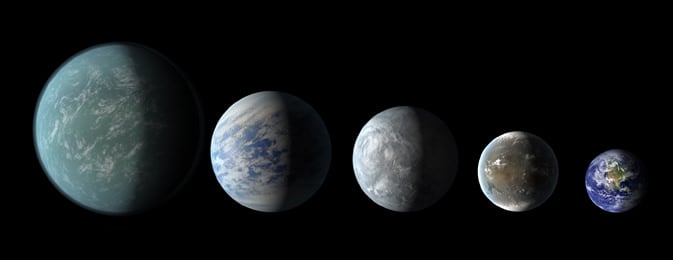The Kepler mission has discovered
two new planetary systems
that include three super-Earth-size planets in the "habitable zone," the range of distance from a star where the surface temperature of an orbiting planet might be suitable for liquid water.
The Kepler-62 system has five planets; 62b, 62c, 62d, 62e and 62f. The Kepler-69 system has two planets; 69b and 69c. Kepler-62e, 62f and 69c are the super-Earth-sized planets. (Read all the details in our full article
here.
)
The new planets brings the number of confirmed exoplanets to 861. According to the Planetary Habitability Laboratory, there are now nine potential habitable worlds outside of our solar system, with 18 more potentally habitable planetary candidates found by Kepler waiting to be confirmed. Additionally, astronomers predict there are 25 potentially habitable exomoons.
Here is some of the imagery (sorry, but they are artists concepts!), graphs and video used in today's briefing about the new discoveries, as well as some some from the
Planetary Habitability Laboratory
:
Here's a flythrough of the Kepler 62 system:
[caption id="attachment_101554" align="aligncenter" width="580"]
The diagram compares the planets of the inner solar system to Kepler-69, a two-planet system about 2,700 light-years from Earth.
Image credit: NASA Ames/JPL-Caltech
[/caption]
[caption id="attachment_101558" align="aligncenter" width="580"]
Much like our solar system, Kepler-62 is home to two habitable zone worlds. The small shining object seen to the right of Kepler-62f is Kepler-62e. Orbiting on the inner edge of the habitable zone, Kepler-62e is roughly 60 percent larger than Earth. Image credit: NASA Ames/JPL-Caltech.[/caption]
[caption id="attachment_101561" align="aligncenter" width="580"]
The diagram compares the planets of the inner solar system to Kepler-62, a five-planet system about 1,200 light-years from Earth. Image credit: NASA Ames/JPL-Caltech[/caption]
[caption id="attachment_101562" align="aligncenter" width="580"]
Current known potentially habitable exoplanets. Credit: Planetary Habitability Laboratory/University of Puerto Rico, Arecibo. [/caption]
[caption id="attachment_101563" align="aligncenter" width="580"]
Current potentially habitable exoplanets showing the new additions, Kepler-62e and Kepler-62f. Credit: Planetary Habitability Laboratory/University of Puerto Rico, Arecibo. [/caption]
[caption id="attachment_101564" align="aligncenter" width="580"]
Comparison of the orbit and size of the exoplanets of Kepler-62 with the terrestrial planets of our Solar Systems. The darker green shaded area corresponds to the 'conservative habitable zone' while its lighter borders to its 'optimistic habitable zone' extension. Planet sizes and orbits are not to scale between them. Credit: Planetary Habitability Laboratory/University of Puerto Rico, Arecibo.[/caption]
 Universe Today
Universe Today
